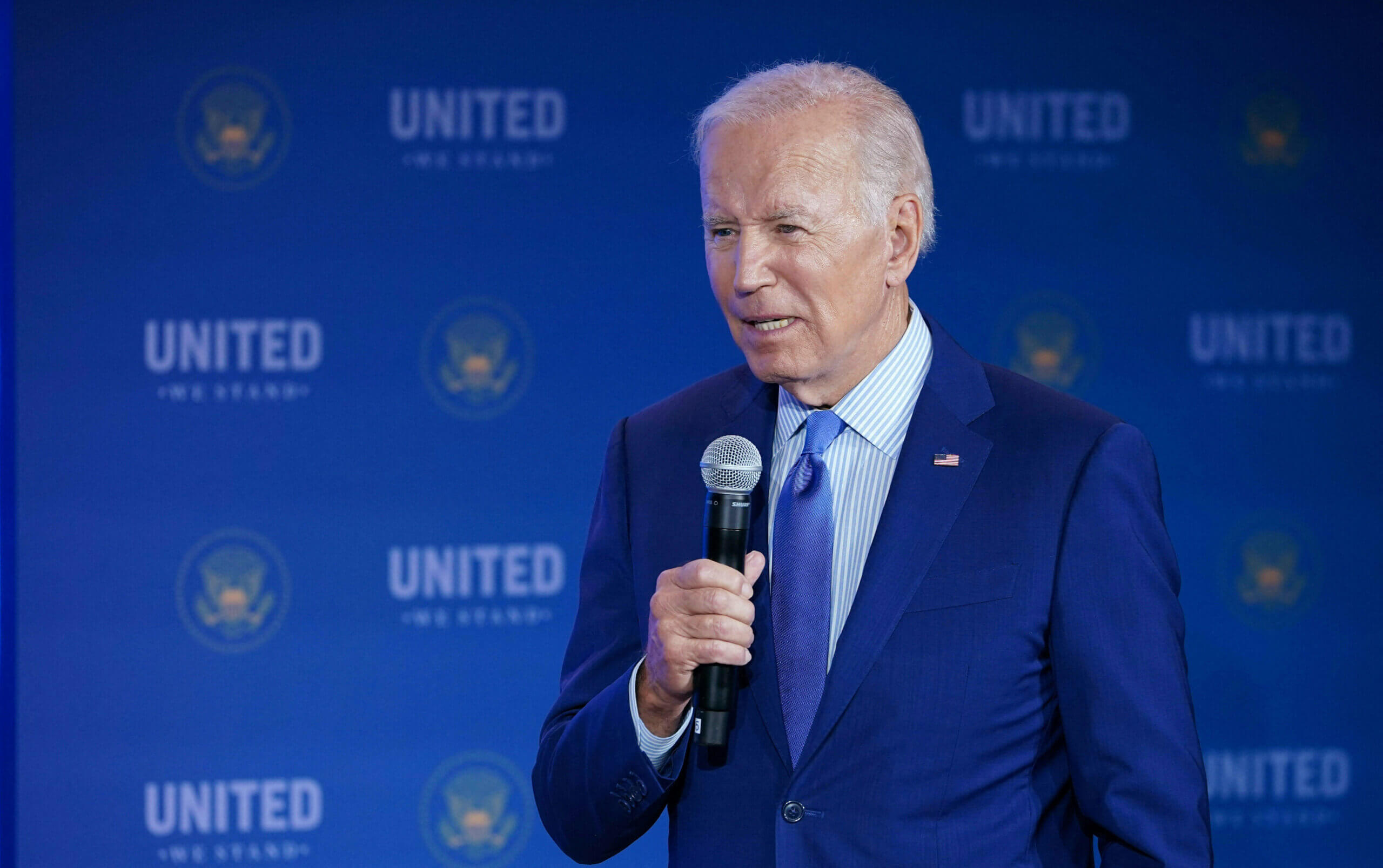Israel ‘mudslinging’ threatens to overshadow White House antisemitism strategy
Both sides say debate over what definition of antisemitism should be used is a waste of energy — but that hasn’t dampened the dispute

Second Gentleman Doug Emhoff on May 16, 2023. Photo by Chip Somodevilla/Getty Images
As the White House prepares to release the first national strategy to counter antisemitism, one topic is taking center stage: Israel. The country’s most powerful Jewish organizations are pushing hard for federal officials to classify harsh criticism of Israel as a form of antisemitism.
The Anti-Defamation League and American Jewish Committee, among others, are insisting that the White House adopt the International Holocaust Remembrance Alliance’s controversial definition of antisemitism. It’s been used to condemn a wide range of criticism of Israel, including political boycotts and reports from human rights organizations, as forms of discrimination against Jews. It’s also been invoked to discredit financial firms’ investment scorecards.
While the plan is expected to feature the IHRA language when it is released Thursday, proponents of the definition are worried that the Biden administration may include other definitions in its national strategy that would carve out more space for criticism of Israel.
“To be clear, the ADL believes that the IHRA definition is the indispensable tool for defining antisemitism,” Jonathan Greenblatt, the organization’s chief, said on Twitter. “No other definitions work.”
But the fight over whether the White House should embrace the IHRA definition is about much more than what reference government officials should look to when adjudicating allegations of antisemitism: It hinges on competing visions of Jewish safety. Progressives see white supremacy as the greatest threat to Jews and focus on building broad coalitions to stop far-right extremism. Centrist organizations and those on the right emphasize defending Israel and explaining the ways that antisemitism is different from other forms of racism.

There is meaningful overlap between these two strategies. The ADL, for example, has said that the far-right is the top threat facing American Jews even as Greenblatt has equated anti-Zionist activists with white supremacists. But they have also led to deep divisions in the Jewish community. President Joe Biden frequently spoke of the need to fight extremism early in his presidential campaign, but his administration has sought to avoid getting bogged down in the debate over whether criticism of Israel should factor into these plans.
The plan to release a national strategy to counter antisemitism was announced last fall following a series of antisemitic comments made by rapper and megacelebrity Kanye West, now known as Ye, and a significant rise in antisemitic incidents that alarmed Jews.
Mainstream Jewish organizations have been working hard to convince the White House to use the IHRA definition — and that definition alone — in its strategic plan, which was originally expected to be released last week.
The Conference of Presidents of Major American Jewish organizations sent a letter last Friday signed by hundreds of rabbis calling for the administration to “formally embrace the IHRA Working Definition as the official and only definition used by the United States government.”
The World Jewish Congress and ADL promoted a video on social media defending the IHRA definition against charges that it would limit free speech. It features a woman wearing a hat that reads “Make Israel Palestine Again” as an example of a statement the definition would consider antisemitic.
And Ken Marcus, a civil rights official during the Trump administration, warned in the Jewish Journal that including any alternative definition “will severely undermine Biden’s antisemitism plan,” while right-wing media outlets like the Washington Free Beacon and JNS have run pieces warning that the White House might do just that.
Others have tried to throw cold water on the definitions dispute, though so far to little avail.
“Whose interest does it serve when this signature effort has devolved into mudslinging over definitions?” asked Carinne Luck, international director of the Diaspora Alliance, which is critical of the IHRA definition. “I want American Jews to be looking at what is in the strategy — what are the policies — not who said what about which definition.”
Dueling definitions
The IHRA definition, which originated in a document released by the European Union in 2005, has been aggressively promoted by many leading Jewish in the U.S. since the end of the Trump administration and has been embraced by some Biden officials, including Secretary of State Anthony Blinken. It has also been endorsed by dozens of state legislatures and local governments.
In response, two alternative texts have emerged. The Jerusalem Declaration on Antisemitism was released by a group of progressive Jewish academics two years ago, and has since been backed by hundreds of scholars, shortly after a smaller cohort of experts working out of the University of Southern California released another definition known as the Nexus Document.
Embraced by many activists, the Jerusalem Declaration explicitly defends boycotts targeting Israel. Nexus, which the White House is reportedly considering including in its report as a “resource” alongside IHRA, takes a more moderate approach that seeks to clarify some of the IHRA language.

For example, the IHRA definition describes “applying double standards” to Israel “by requiring of it a behavior not expected of any other democratic nation” as a possible example of antisemitism. The Nexus Document qualifies that by specifying that a double standard is antisemitic if one treats “Israel differently solely because it is a Jewish state.”
Nexus organizers have said their definition can be used as a complement to IHRA, although some of IHRA’s staunchest promoters have dismissed this claim. Greenblatt referred to both the Jerusalem Declaration and Nexus as being created through a “pasted-up process organized by activists.”
Tema Smith, the ADL’s director for Jewish outreach, and an opinion columnist for the Forward, is one of the authors of the Nexus Document.
A proxy war
Observers on both sides of the debate have noted that the community seems to be squandering precious resources by fighting over language. “I don’t think we can or should or can afford to have attention diverted from the major issue, which is fighting antisemitism,” Mark Weitzman, who spearheaded the International Remembrance Holocaust Association’s endorsement of the working definition, said last week.
Bend the Arc, a progressive advocacy group, made a nearly identical case for why the Biden administration should reject the IHRA definition.
“It just feels unnecessary and distracting to spend so much time that really should be about what it takes to fight hate, fight antisemitism, fight white supremacy, on parsing a definition,” Jamie Beran, the organization’s chief executive, said in an interview.

The vision of Jewish safety presented by organizations with the largest budgets and political power, like the the ADL, Hillel and the sprawling Jewish federation system, is one in which American Jews are shielded from both traditional antisemitic threats — like white supremacist violence — and what they consider to be new manifestations of antisemitism, like the accusation that Israel and its supporters are racist. These organizations hold that a positive attachment to Israel is an integral part of Jewish identity for many Jews, and should be protected in a similar manner as Shabbat observance would be.
A number of Jewish organizations celebrated a landmark victory promoting this view three years ago, when the University of Illinois released a statement that classified pro-Israel students as a protected class at the school. “For many Jewish students, Zionism is an integral part of their identity and their ethnic and ancestral heritage,” a statement announcing the move read. “These students have the right to openly express identification with Israel.”
Though it is more vague, the IHRA definition gives force to this understanding of antisemitism, rooted in what some scholars call “new antisemitism,” which holds that antisemitism has morphed into animus toward Israel.
“All that has happened is that it has moved from discrimination against Jews as individuals in their respective host societies — a classical antisemitism,” Irwin Cotler, a Canadian academic, wrote in 2009, “to discrimination against Jews as people — and Israel as the collective Jew among the nations — a new antisemitism.”
The Israeli government has strongly endorsed this view.
Opponents of this understanding counter that while Israel can be connected to some forms of antisemitism — like singling out Jews for litmus tests on Israel and Zionism — it is a mistake to focus attention in that area. Bend the Arc and other progressive groups say the work of combating antisemitism should be integrated into the broader fight against white supremacy and other forms of extremism that threaten both Jews and other minority groups in the U.S.
“The message we’re rejecting is the idea that somehow Jews and our safety are separate from other people,” said Luck, with the Diaspora Alliance, which promotes the Jerusalem Declaration. “It’s not just a neat slogan that ‘our safety is in solidarity,’ it is a true political statement.”
Polling shows mixed views
Both sides marshall statistics.
Holly Huffnagle, director of combating antisemitism for the American Jewish Committee, pointed to her organization’s polling that showed 87% of Jews in the U.S. believe that “Israel has no right to exist” is an antisemitic statement. “The loudest voices against IHRA — or against even wanting to connect antisemitism and Israel — seem to be much larger in number when they’re actually not that many,” Huffnagle said.
Those who want to avoid a focus on Israel point to data in another AJC survey showing that American Jews find the far-right, which is typically associated with white supremacy, a much greater menace than the far-left, where some the most strident criticism of Israel takes place. Nearly half of respondents said the “extreme right” was a “very serious” threat, compared to 19% who said the same about the left.
And a 2021 poll from the Jewish Electorate Institute found that 25% of Jews in the U.S. believe Israel is an apartheid state, while 28% believed that claim was antisemitic.
Parsing the definition
Most of the controversy around the IHRA definition hinges on the 11 examples that accompany it, which groups that promote it generally insist be included when it is used. Six of the examples address Israel, and include “denying the Jewish people their right to self-determination,” claiming that Israel is “a racist endeavor,” and comparing Israel to Nazi Germany.
But the examples include a big caveat. The definition says only that the examples “could, taking into account the overall context” be antisemitic. Some critics say this is a weakness because, on its face, it forces people using the definition to adjudicate every incident on a case-by-case basis — in order to consider the context — damaging the utility of a standard definition.
Others argue that the flexibility can be helpful. Huffnagle, with the AJC, said she generally believed anti-Zionism — “denying the Jewish people their right to self-determination,” per the IHRA definition — was antisemitic.
“But it’s much more complicated than that,” she added. “I would not call Palestinians who were forced to leave their homes and think Israel should be part of one state — I’m not going to call them antisemites.”
Overshadowing the substance
The White House appears to have been caught off guard by the furor over the definitions. Officials asked organizations that had conferred with the reports’ authors to submit final feedback last. But sources familiar with the timing said the initial plan to release the report was pushed back at the last minute.
Second Gentleman Doug Emhoff, who is Jewish and convened the task force working on the strategy, has said little about his views on the relationship between Israel and antisemitism and likes to frame his work as a way to bring American Jews together. The Biden administration has sent mixed messages on its support for the IHRA definition, with Blinken’s wholehearted endorsement set against a decision by the Education Department in January to shy away from encouraging schools to rely on the definition.

Deborah Lipstadt, the State Department’s international antisemitism envoy, tried to convince Jewish leaders last week that the strategy should not be boiled down to its position on Israel. “Don’t look at the jar, look at what’s inside of it,” she said.
White House officials have also reportedly sought to reassure Jewish leaders who support IHRA that any mention of the Nexus Document would not detract from the plan’s endorsement of the working definition, which will also be prominently featured in the strategy.
Officials said that the plan will include over 200 policy recommendations, including proposed legislation and steps that can be taken by state and local governments, corporations, social media companies and others to address antisemitism.
Observers will be looking to see whether the plan suggests boosting security funding for Jewish institutions and expands Lipstadt’s mandate to include domestic antisemitism or recommends appointing another official for that role.
“There will be some reference to the questions of definitions as they relate to Israel,” said Jonathan Jacoby, who led the Nexus Taskforce. “But it will be a very small part of the strategy, as it should be, because antisemitism, in the end, is about antisemitism.
“Seeing it through the lens of a particular political perspective just weakens the fight.”

















